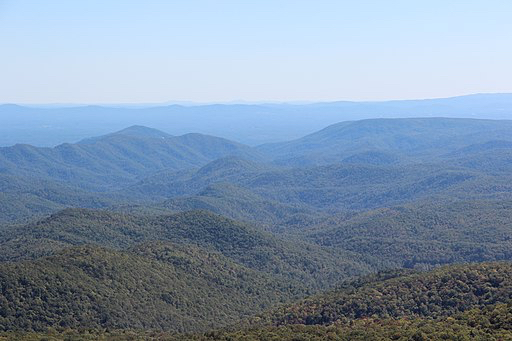The Mystery of the Brown Mountain Lights
Of all the ghost stories, mysteries and legends in the mountains of North Carolina, one of the most enduring and fascinating is the Brown Mountain Lights. I remember in my early twenties, driving out with a group of friends down the Blue Ridge Parkway toward Linville Gorge, and seeing the eerie spheres of light rise off the mountain and disappear. Weirder still, as we drove closer to them, they seemed to disappear entirely.
Brown Mountain photo by Thomas200, courtesy of Wikimedia Commons
If you want to see the Brown Mountain Lights for yourself, you should head to the Pisgah National Forest on a clear night in October after the leaves have fallen from the trees. There are three spots most commonly used to view them, but there’s no guarantee, and many people have spent all night sitting on the hood of their cars without seeing anything out of the ordinary.
Brown Mountain Overlook is located twenty miles north of Morganton on NC highway 181, 1 mile south of the Barkhouse Picnic Area.
Wiseman’s View Overlook is five miles south of Linville Falls on Old NC 105.
Lost Cove Cliffs Overlook is at milepost 310 on the Blue Ridge Parkway two miles north of NC Highway 181 junction.
If you’re one of the fortunate few, you’ll see different colored globes of light rise up from the mountain, floating along the ridge, some changing colors before disappearing from view.
The Legends Behind the Lights
Three different legends surround the mystery of the Brown Mountain Lights. The earliest stems from a battle between the Cherokee and Catawba Indian tribes in 1200 AD. According to the Cherokee, the lights are the spirits of Indian women searching for their mates who died in battle on the mountain. Another legend arose in 1850 around a woman who disappeared and was supposedly murdered by her husband. Those searching for her body saw the mysterious lights and claimed it was her spirit come back to haunt her murderer and warn people away from the area.
The most famous legend of all was related by a member of one of the first families to settle in the region, Fate Wiseman. He told of a southern planter who went hunting in Linville Gorge and never returned. One of his slaves was sent to find him, although he was never found and the slave never returned. The legend claims the lights are from the faithful slave’s lantern forever searching in vain.
Scotty Wiseman took his great-uncle Fate’s story and turned it into a song, which he performed as part of the early 60s duo, Lulu Belle and Scotty in 1962. The song was also performed by Tommy Faile and The Kingston Trio.
Science Explains the Origin of the Lights
Check out the lights without making the trek out to Brown Mountain itself; Ed Speer provides several good photographs of the “mysterious” lights along with strong evidence that the origin of the lights is refracted light from the manmade electric lights of nearby towns such as Lenoir and Connelly Springs. Other, somewhat less likely, explanations include Foxfire (the phosphorescent light emitted by certain fungi on decaying timber), car and train headlights, brush fires, swamp gas, deposits of radioactive uranium ore, and a favorite, fires from moonshine stills.
According to a writer at Western NC Attractions, the argument that the lights are from nearby towns doesn’t hold true because the lights were reportedly seen as early as “The War Between the States,” long before the invention of electric lights. Also, the theory that the lights are from trains or automobiles fails due to a great flood in 1916 that knocked out the railroad bridges, washed out roads and downed power lines. The lights were still visible during the weeks until the right-of-way could be repaired and locomotives could barrel through Catawba Valley as they had before.
Whether you believe the scientific explanation of refracted city lights or prefer the legends surrounding them, the Brown Mountain Lights are one of North Carolina’s more mysterious attractions and worth a night drive for a closer look this fall.
Stay up to date with other Appalachian region events and craft shows by following Got Mountain Life on Facebook, Twitter, and Instagram. Be sure to visit our events calendar often!


